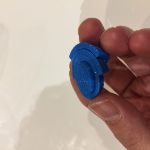Creating a new product is one of the most exciting parts of owning a business. New products have the potential to change the face of the industry and having an active hand in the process is a thrilling experience. Getting a product design from a concept to a finished piece can be a complex process, however, and it is easy to end up with something less than ideal.
If you’re a new business owner, or perhaps you are new to manufacturing a product, getting the best possible product is probably at the forefront of your mind. If you’ve never done it before, here is a basic walkthrough on how to turn your idea into a physical object you can hold in your hands—and more importantly– sell to eager customers.
Table of contents
Defining mass production
Before you start filling out forms and talking to representatives, it’s helpful to understand what mass production is, and whether or not a manufacturer actually fits your needs. In the manufacturing industry, there are three different types of products that can be made. Each product type means something completely different, so if you ask for one product and mean another, you may be disappointed with the results.
☑Pre-Production Prototype
 If your product is not ready for sale yet, and you need a small batch made to attract potential investors or to test the viability of your product, you are looking for a prototype. After you have designed your product, prototypes are an important next step, and not all of them can be made in your own home. Sometimes it is necessary to have a manufacturer make your initial prototypes for you, especially if you don’t have the necessary equipment or materials at home to make more than a basic example of your product. Often, manufacturers don’t offer design services and you will need to find a firm that offers CAD services or 3D modeling company to help design your new product.
If your product is not ready for sale yet, and you need a small batch made to attract potential investors or to test the viability of your product, you are looking for a prototype. After you have designed your product, prototypes are an important next step, and not all of them can be made in your own home. Sometimes it is necessary to have a manufacturer make your initial prototypes for you, especially if you don’t have the necessary equipment or materials at home to make more than a basic example of your product. Often, manufacturers don’t offer design services and you will need to find a firm that offers CAD services or 3D modeling company to help design your new product.
The biggest differences between a prototype and the final design come down to the number of products made, and the materials used. For example, a prototype will use cheaper materials, replacing expensive metal with plastic and only a small number will be produced Be prepared for the price of prototypes to be more expensive, despite these facts, however, since prototypes are a somewhat specialized field.
☑ Mass Manufacturing
 When you are satisfied with the prototype and are ready to produce, you are ready to mass produce it. Mass producing involves ordering thousands of the product at a time, to lower production costs and get a reasonable number to sell. If you’re a small start-up, you may want to look for a manufacturer with a low minimum order, so you can start out small and test the market or look into single batch manufacturing.
When you are satisfied with the prototype and are ready to produce, you are ready to mass produce it. Mass producing involves ordering thousands of the product at a time, to lower production costs and get a reasonable number to sell. If you’re a small start-up, you may want to look for a manufacturer with a low minimum order, so you can start out small and test the market or look into single batch manufacturing.
☑ Single Batch Manufacturing
Single batch manufacturing is similar to mass manufacturing, except for that the batch is done one time in a factory and may be done one step at a time. The cost per item may be higher, but you’ll be able to order fewer of them to get your first run off the ground.
Because mass production involves a significant investment, it’s important to make sure you are completely happy with a product before getting to this stage. No matter how good a manufacturing company is, there is always a bit of a leap between what you imagine and what the manufacturer makes. Getting your idea and the final product to align takes communication, and it is important to do so before you have 10,000 imperfect products.
Knowing the difference between the different terms used in manufacturing will help you order the product you want. Before contacting manufacturers, it’s useful to be able to describe what you are looking for so that the company can have an easier time creating your product.
Now that we have a basic understanding of what types of manufacturing are available, let’s take a look at some other choices available.
Domestic vs. Overseas
 When we think of getting a product mass produced, we tend to think of faraway places such as China or Taiwan (see The Pros and Cons of Manufacturing in China to learn more about the topic). These are friendly markets and often offer relatively inexpensive products compared to what can be found locally, so choosing an overseas location makes sense most of the time. There are a few times, however, when it may be best to choose a domestic producer.
When we think of getting a product mass produced, we tend to think of faraway places such as China or Taiwan (see The Pros and Cons of Manufacturing in China to learn more about the topic). These are friendly markets and often offer relatively inexpensive products compared to what can be found locally, so choosing an overseas location makes sense most of the time. There are a few times, however, when it may be best to choose a domestic producer.
If you are looking for a very small scale producer, creating 1,000 or less of a high-quality product, a domestic producer may be a better choice. Many small, local manufacturers cannot only create a product for you but sometimes can even give you tips and ideas to improve a product in a field where they have experience.
Local production can also offer some marketing appeal, as customers often like to purchase products made in their own country.
Choosing between domestic and overseas manufacturing comes down to personal choice, and what you feel works best for your product. You may already have an idea of which situation you feel is best, but researching both local and foreign manufacturers may give you more options in your search for the best company to create your product.
Creating your first prototype
If your product is still in the concept phase, you’ll need a prototype before you can find a manufacturer to build it for you. Many times, you can build it yourself. Sometimes you might need the help of a manufacturer specializing in prototypes to get an example that is usable for demonstration.
Manufacturers that specialize in prototypes can handle small-scale production and are familiar with the process of converting your ideas into a workable concept piece. This stage can often be the trickiest part of getting a prototype made, because no matter how clearly you state what is in your head, what is produced is often at least a little different.
 They will build a prototype as closely as possible to your specifications, and then send it to you to be inspected. Once you receive it, it is your job to see how closely it matches your ideas. Can it be opened/closed if it needs to? Do lids fit properly? Does it have zippers, if so can it zip and unzip? For clothing or other items, can it be washed? Is there any damage when you put it through the washer and dryer?
They will build a prototype as closely as possible to your specifications, and then send it to you to be inspected. Once you receive it, it is your job to see how closely it matches your ideas. Can it be opened/closed if it needs to? Do lids fit properly? Does it have zippers, if so can it zip and unzip? For clothing or other items, can it be washed? Is there any damage when you put it through the washer and dryer?
You may have to request several adjustments before the prototype is in working condition. Once it is, you’ll want to order a minimum of 1 dozen to be made because each manufacturer you look at will want to see the prototype, and you may need more than one to determine whether they can build it or not.
Prototypes don’t have to be perfect to be usable, but they do need to clearly get the message across manufacturers about for what you are looking. Be sure you get this step right when creating your prototype, even if you have to do the work yourself or have to experiment extensively to get a good finished result.
Finding a manufacturer
 Once you have your prototype and have decided where to begin looking for a manufacturer, your next step is to start contacting companies who can potentially build your product. You may find yourself working with this manufacturer for many years, so it is important to pay attention to details when searching for one. Whether or not you get along with the team that works with you can be just as important as how well they manufacture your product when you may be dealing with these people daily over an extended period.
Once you have your prototype and have decided where to begin looking for a manufacturer, your next step is to start contacting companies who can potentially build your product. You may find yourself working with this manufacturer for many years, so it is important to pay attention to details when searching for one. Whether or not you get along with the team that works with you can be just as important as how well they manufacture your product when you may be dealing with these people daily over an extended period.
There are several methods of selecting a manufacturer, but referrals are one of the best methods for finding a good company. The recommendations of other people who have worked with them one-on-one go a lot farther than anything you might be able to see on a website.
If you’re new to the business, you may not necessarily know anyone who has built a product similar to yours. Fortunately, you don’t have to rub elbows with other CEOs on a daily basis to get recommendations. Instead, research other products similar to yours, and call the companies. Most will be happy to tell you who their manufacturer is, and you can use these recommendations to form some basic choices about where to go from there.
A common pitfall when seeking a manufacturer is to go with the first one or two manufacturers you find. It’s best to find a minimum of three manufacturers that you like before deciding between them to compare them carefully.
Questions to ask yourself before deciding include:
Who is most pleasant to work with?
 It may seem like the only thing that should matter is the end product but remember you may be dealing with the same people for years. Your work will be less stressful and more enjoyable if the people who you contact are nice. It can also help improve your product. Other related questions to ask yourself include how informative they were, how well your questions were answered, and how quickly the company got back to you. Long delays in answering questions could be a sign that your product will also be delayed, which may be unpleasant if you need products promptly.
It may seem like the only thing that should matter is the end product but remember you may be dealing with the same people for years. Your work will be less stressful and more enjoyable if the people who you contact are nice. It can also help improve your product. Other related questions to ask yourself include how informative they were, how well your questions were answered, and how quickly the company got back to you. Long delays in answering questions could be a sign that your product will also be delayed, which may be unpleasant if you need products promptly.
How do they measure up to your expectations?
This one may be a little harder to gauge before you’ve worked on a product together, but you can still discern some of it based on how they handle you. If they are polite and friendly, answer your questions, and get back to you right away it’s a positive sign they will handle your product properly too. If you got their information from a referral, you could also ask the company who referred you how well they complete finished products promptly.
If you have chosen to work overseas, you may find it beneficial to hire an agent to help you find a manufacturer or to work with the one you have chosen. Agents or brokers that represent the company you are interested in have seen the facility first hand and are experienced with how the company functions. They may be able to answer questions about the details of how the manufacturing process is done.
Once you’ve spoken with at least 3-4 different companies and selected the ones you like best, it’s time to ask about pricing and to negotiate the best deal.
Getting quotes
Now that you have found several companies that you like, you can ask for a quote on the number of products you need. As long as you are confident that the quality will be the same, there is no reason not to price shop after you’ve chosen based on quality.
Before you can get quotes, you’ll need a few things first. You’ll want to sign a Non-Disclosure Agreement. This agreement is important for the safety of your business. An NDA allows you to share trade secrets with the manufacturer—a necessary step in getting a product made—without concern about them selling or using the product information themselves. Never send your product to a manufacturer without a signed NDA.
Once you have received your quotes, it’s time to compare them. A common mistake is to choose the lowest total quote, but a low quote doesn’t always mean the lowest total price. It’s important to compare quotes carefully to make sure the quotes are covering the same things.
Is shipping included in all of your quotes?
 If the quote covers the price of manufacturing, the end price may be more than expected. It may well be more than the cost of a more expensive quote that included shipment. You may also need to pay attention to what kind of shipping is available. If your product requires special shipment methods, but the quote you received is for basic freight, it may not compare properly to a different quote.
If the quote covers the price of manufacturing, the end price may be more than expected. It may well be more than the cost of a more expensive quote that included shipment. You may also need to pay attention to what kind of shipping is available. If your product requires special shipment methods, but the quote you received is for basic freight, it may not compare properly to a different quote.
Are the quotes suspiciously low?
Some manufacturers will offer discounts and quotes that are simply too good to be true. If it seems too good to be true, it probably is, and the manufacturer won’t be able to uphold the offers that they made to attract your business. It’s fine to choose the lowest amount, of course, but if the discounts offered are drastically lower than other quotes, it is wise to be wary of them.
Did the information request form include too little information?
To provide you with an accurate quote, the manufacturer will need to ask you a lot of questions. Typical questions include, but are not limited to, the following:
☑ Size of the product
Without the size and dimensions of what you are trying to create, determining shipping and material costs will be impossible.
☑ Materials
The material that the product is to be made out of will greatly affect the price of the end product. Plastic is cheaper than metal, and some types of cotton are more expensive than others.
☑ Intended use
If your product is new, explaining how it is used may help the manufacturer come up with suggestions to make it better, or to select appropriate materials. You wouldn’t want a child’s toy to be made out of a porous material that is difficult to clean, or a recycling container made out of cloth that will stain or hold smells.
☑ Order quantities
This element is a big one, as the minimum quantities can vary vastly between companies. If you only need 500 products, you may want to use a company that specializes in small batches. You’ll also want to find out the cost of yearly purchases. Your first order might cost less because of first-time buyer discounts.
☑ Packaging requirements
Please make sure they understand the packaging requirements for your product. You don’t want to get delicate goods back damaged, and if the packaging doesn’t look the way you want it, the product may not sell well. Different styles of packaging have different prices, so add all of the important details at the beginning to help them give you an accurate estimate.
☑ Manufacturing technology requirements
While a pillowcase with your custom design won’t take any special technology to create, one that has a new component in it so that it always stays icy cold might. If the technology involved is advanced, the CM may need expensive equipment to create it. In that case, such expenses will be a factor in how much your run will cost.
☑ Drawings, pictures, and blueprints
The more professional the designs you can provide, the more seriously your supplier will take your product.
All of these things are important for getting an accurate quote on your product. If they aren’t included, you may discover the price is much higher when you finally get your product back.
Negotiating
 The initial quote you receive doesn’t always have to be the price you pay. In the United States, the price you receive is typically the price you expect to pay, but in the manufacturing business, things are a little different. Manufacturers expect you to negotiate, and the quote may well reflect that. Once you have received a quote from the manufacturer, give it a few days and then ask for better pricing. You may be pleasantly surprised to discover the price you found barely acceptable is now reduced to an amount that will allow for a comfortable profit margin.
The initial quote you receive doesn’t always have to be the price you pay. In the United States, the price you receive is typically the price you expect to pay, but in the manufacturing business, things are a little different. Manufacturers expect you to negotiate, and the quote may well reflect that. Once you have received a quote from the manufacturer, give it a few days and then ask for better pricing. You may be pleasantly surprised to discover the price you found barely acceptable is now reduced to an amount that will allow for a comfortable profit margin.
Even if your manufacturer can’t reduce the pricing, you will never know if you don’t ask. Overpaying for a product is a lot worse than asking about a lower price and getting refused.
Visiting the Factory
 If you choose to hire an agent to help you deal with a manufacturer, this step may not be necessary, but it is still an important option to consider. Getting a product manufactured costs thousands of dollars. Even a small run of products involves a great deal of money. When you consider how much is at stake financially, it makes sense to tour the facilities that will be making your product personally before choosing a place to manufacture your products.
If you choose to hire an agent to help you deal with a manufacturer, this step may not be necessary, but it is still an important option to consider. Getting a product manufactured costs thousands of dollars. Even a small run of products involves a great deal of money. When you consider how much is at stake financially, it makes sense to tour the facilities that will be making your product personally before choosing a place to manufacture your products.
Visiting a far away place such as China or Taiwan may seem like an unneeded expense when there are so many other ways to communicate, but compared to a $100,000 run of products, a few thousand in tickets and hotels is relatively cheap to ensure all goes well.
If you can, schedule a visit with all of the companies you are interested in, and take the time to look at the facilities that will be making your product. Many times, the factories are relatively close together, so you may be able to view all of your candidates without moving between hotels.
It’s important to see how things are run first hand, to be certain that your product will be made well and correctly. There is only so much information that Skype, phone, and e-mail can convey. By visiting the factory in person, you can clear up any communication issues and make sure the company has the required technology to make your product.
You may also learn a lot more about your type of product through visiting. Some products are only partially done by machine, with vast parts of the process done by hand. It’s useful to become familiar with the process your product may go through to be completed.
Visiting will also help you establish bonds with the company that will hopefully serve you for the next several years as a great opportunity overall.
Production
 After you have found a great manufacturer, selected the manufacturer you like best, and gone through the sampling process, it’s finally time to produce your product. When you are ready to order, the company will most likely send you some paperwork to fill out. This paperwork includes a work order, of which you will definitely want to have a copy.
After you have found a great manufacturer, selected the manufacturer you like best, and gone through the sampling process, it’s finally time to produce your product. When you are ready to order, the company will most likely send you some paperwork to fill out. This paperwork includes a work order, of which you will definitely want to have a copy.
The work order explains in detail what the company will, and will not, cover. That may mean that if you made a mistake in the sampling process and ordered the wrong version, you won’t have a way to fix it once the product is already made. It’s important to read this work order carefully and be as specific as possible, especially, if you see anything that seems out of order.
It typically takes several weeks to finish an order, and it may be longer depending on local holidays and customs. It’s important to pay attention to these cultural details and plan ahead, especially if the product you are creating is time sensitive. Plan on at least 3-4 months between placing the order and receiving the product, since you will also have to account for shipping times, especially if you have ordered from overseas.
The manufacturer will probably request that you pay part of the fee for creating the product up front. You can expect to pay roughly a third of the purchase price before the sampling process, another third when the products have shipped, and the final payment after you have received the goods. Be wary of manufacturers who demand all of the money at once. This practice is a bad sign.
The first order you place will probably feel a little hectic, but don’t worry. As time goes on you and your manufacturer will get to know each other, and the road to producing a product will get smoother. Looking forward to a new shipment of beautifully packaged goods every few months is a satisfying way to complete the process from prototype to finished product, and with luck, you will keep producing your product for years to come.
Being a good customer
Finding a manufacturer to create your product is a serious undertaking. The manufacturer that you work with will be one that you hope will continue to do business with for many years. Once you have found a manufacturer that pleases you, it is important to take steps to build a decent relationship with the people who will be helping create your new product.
While you may think simply making sure the checks don’t bounce is all you need to do to maintain a good business relationship, there’s a lot more that can be done to help your relationship with a CM thrive. If you find a great CM that truly makes you happy, it makes sense to do everything possible to make them glad you are their customer. Here are a few things you can do to help keep everything running smoothly.
Keep your manufacturer in mind when designing your product
When you’re in the middle of the creative process, taking the time to think about your manufacturer probably didn’t cross your mind. Yet, how you design your product can determine how easy it is to manufacture.
With new products, or if you are new to product design in general, you might not know what makes something difficult to manufacture. If you’re not sure, it’s okay to ask the manufacturer what you can do to make things easier. Not only will they have a ready response, but the fact that you are interested in making their lives easier will also go a long way to strengthening your working relationship with them.
Don’t make dramatic changes after the sample phase
The whole point of hiring a manufacturer for mass production is to take advantage of their ability to mass produce. Manufacturers can’t do that if you keep making changes to the order. While you can and should be as picky as possible during the sample phase after the product is in full production a change means completely stopping and starting over.
Sometimes you will have to make changes to the order, especially if there is a safety issue or other critical problem, but keeping those changes to a minimum will go a long way to optimizing the production process. Your manufacturer’s goal is to produce your product with the lowest possible cost and the highest possible performance; help them do that by avoiding changes as much as possible.
At least make minimum order size
This one might seem obvious, but many businesses end up failing to make the minimum order size or cut back on the size of their order severely. This situation puts the manufacturer in a terrible bind because the space on their manufacturing floor could have been used for something more profitable. Expecting to make a certain amount of money and watching that amount be drastically reduced can be terrible for their bottom line, and put a lot of strain on their business. While they may handle it skillfully and politely, they probably won’t enjoy getting orders from you in the future.
Answer your phone
 When a manufacturer calls you, they typically need your attention promptly. The longer you fail to respond to their attempts to contact you, the longer your product may be off the manufacturing line. If you get a call from your manufacturer, always respond promptly. It may be a small error in the paperwork that needs to be attended to, or it may be a production problem that brings everything to a halt until you answer.
When a manufacturer calls you, they typically need your attention promptly. The longer you fail to respond to their attempts to contact you, the longer your product may be off the manufacturing line. If you get a call from your manufacturer, always respond promptly. It may be a small error in the paperwork that needs to be attended to, or it may be a production problem that brings everything to a halt until you answer.
If you can’t be reached, your product is likely to be removed from the production line to make room for customers that are responding. At best, it will put a strain on your relationship, at worst a good manufacturer may no longer want to work with you.
Maintaining a good relationship with a manufacturer isn’t hard, it just requires common sense. Treat them with the respect they deserve, and you’ll reap the rewards of quality products for years to come.
Signs you need to repair your relationship
While following these tips should help you keep a good relationship with your commercial manufacturer, sometimes these tips come a little too late. If you have been fudging the lines on appropriate behavior with your CM, you may have noticed these signs that they no longer want your business:
☑ They don’t answer your calls
As their client, taking care of your concerns should be their top priority—unless they’re hoping you’ll take your business somewhere else. If your phone calls go unanswered, or it takes days or weeks to get a reply, you may not be their top priority anymore. It could also be they are very busy or have lost team members and don’t have as much time as before, but lack of communication could also be a sign they aren’t pleased with you as a customer.
☑ They charge you for every small change you make
If you’ve fallen short of the minimum requirements for production, or have drastically cut down on your order, you may find the manufacturer is struggling to keep up by charging you for services that were ordinarily included before. This change is often a sign of financial hardship because it isn’t common for a manufacturer to charge fees for every small detail instead of simply following through with their quote.
☑ The team that handles your work has been replaced with new people
The professional, polished team that helped you get started in the process is suddenly no longer available. The team you get instead is new to the business, or perhaps simply less qualified than the other team.
Repairing the relationship may be impossible at this point, but there are things you can do in many cases to repair the damage. A simple apology may go a long way to help, and if the problem is perhaps due to following short on their expectations, an effort to remedy it may help. Unfortunately, once a good relationship has been damaged, it can take a great deal to bring it back from the brink. It may be better to find a new manufacturer completely and to be more careful about managing this relationship.
Of course, it may not be your fault that the relationship is struggling. It could be the manufacturer is in difficulties through their own doing, but regardless it is a sign that the company is not doing well.
Hopefully, however, your interactions with a commercial manufacturer will never fall to damage control. By preventing issues in the first place, you can enjoy the best working relationship possible with your manufacturer and reap the benefits of good customer care.
Getting your product mass produced doesn’t have to be a difficult experience. Most manufacturers enjoy working with new customers and will help you get your product made at every step of the way. By following these steps and planning carefully, you’ll be able to get a good product made at a decent price.
Whether you choose to go overseas or find a domestic factory to help you in your goals, by following these tips, you’ll enjoy the same success with your product creation. Your product is what makes your business unique, and there is something to be said about having an active hand in the process of its production of the way.
Help with New Product Design
Do you need help with new product design? The Cad Crowd community has 20,000+ vetted CAD designers, engineers and industrial designers that can confidentially help with your project. Send your project details for a free design estimate in as little as 24-hours.
